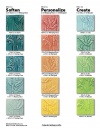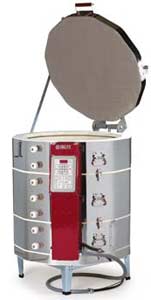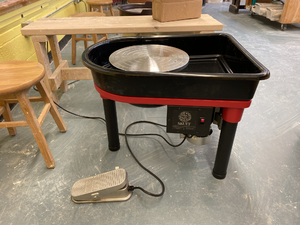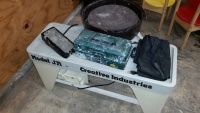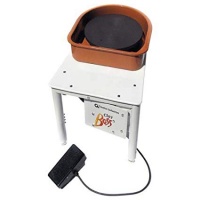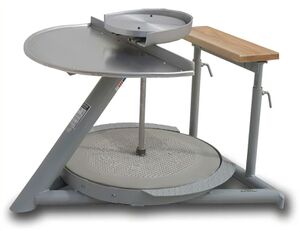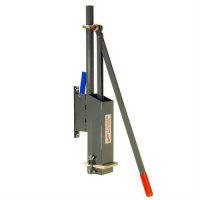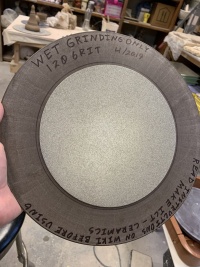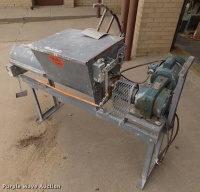Difference between revisions of "Ceramics Area"
Aaron Rivers (talk | contribs) (Lead and Sub-lead update) |
|||
| (67 intermediate revisions by 7 users not shown) | |||
| Line 1: | Line 1: | ||
| − | == General Information == | + | ==General Information== |
| − | + | Ceramics Lead - Russell Owens | |
| − | + | Sub-lead - Thad Lawrence | |
| − | ''Updated: | + | The ceramics studio consists of two rooms. The studio which is approximately 850 square feet and an adjacent kiln room that is approximately 300 square feet. |
| + | |||
| + | If you have questions, put a [https://talk.makeict.org/c/ceramics post on the forum], or send us an email: [mailto:ceramics@makeict.org ceramics@makeict.org] | ||
| + | |||
| + | See: https://talk.makeict.org/g/Ceramics | ||
| + | |||
| + | <center>''Updated: 11/24/2020''</center> | ||
'''The Ceramics Process''' | '''The Ceramics Process''' | ||
| Line 24: | Line 30: | ||
*'''Second Firing - Glaze Firing''' | *'''Second Firing - Glaze Firing''' | ||
**This is the final firing which finishes your piece. This firing finishes the piece and the glaze melts and turns into a glassy coating on the surface. | **This is the final firing which finishes your piece. This firing finishes the piece and the glaze melts and turns into a glassy coating on the surface. | ||
| − | **We glaze fire to Cone | + | **We glaze fire to Cone 5 (mid/high fire, not to be confused with 06 which is low fire). |
| − | ''Updated: | + | <center>''Updated: 1/15/2019''</center> |
| − | == Ceramics Studio Safety == | + | ==Ceramics Studio Safety== |
Safety in the Ceramics Studio falls into two main areas. The first has to do with managing dust and the silica that is naturally present in clay. The second has to do with general tool and studio safety, most of which is common sense. | Safety in the Ceramics Studio falls into two main areas. The first has to do with managing dust and the silica that is naturally present in clay. The second has to do with general tool and studio safety, most of which is common sense. | ||
'''Clay Dust and Silica - What you Should Know''' | '''Clay Dust and Silica - What you Should Know''' | ||
| + | |||
*Clay dust is very fine, much finer than normal household dust. Fine particles of clay dust containing silica can hang in the air for many hours or several days without filtration and/or circulating fresh air from outdoors. You cannot see the dust in the air, but it is still there. | *Clay dust is very fine, much finer than normal household dust. Fine particles of clay dust containing silica can hang in the air for many hours or several days without filtration and/or circulating fresh air from outdoors. You cannot see the dust in the air, but it is still there. | ||
*Long-term repetitive exposure to silica causes fluid buildup and scar tissue in the lungs that reduces your ability to breathe. This can lead to lung scarring and cough, weight loss, and fatigue. | *Long-term repetitive exposure to silica causes fluid buildup and scar tissue in the lungs that reduces your ability to breathe. This can lead to lung scarring and cough, weight loss, and fatigue. | ||
*http://www.lung.org/lung-health-and-diseases/lung-disease-lookup/silicosis/ | *http://www.lung.org/lung-health-and-diseases/lung-disease-lookup/silicosis/ | ||
*While the risk is greatest for workers in industries handling silica containing materials, it is still important to minimize exposure in the ceramics studio. | *While the risk is greatest for workers in industries handling silica containing materials, it is still important to minimize exposure in the ceramics studio. | ||
| + | |||
'''How to Minimize Exposure to Dust and Silica in the Studio''' | '''How to Minimize Exposure to Dust and Silica in the Studio''' | ||
| + | |||
| + | *No sanding of any type is allowed in the ceramics studio. | ||
*Dust control is key to minimizing exposure, and water is your friend. Wet clay doesn’t make dust and is harmless. Follow these tips to help mitigate exposure to yourself and your fellow ceramicists (remember, dust can hang in the air for a very long time): | *Dust control is key to minimizing exposure, and water is your friend. Wet clay doesn’t make dust and is harmless. Follow these tips to help mitigate exposure to yourself and your fellow ceramicists (remember, dust can hang in the air for a very long time): | ||
**Don’t sweep the floor in the ceramics studio! The floor should be wet mopped to pick up and remove dust from the floor. | **Don’t sweep the floor in the ceramics studio! The floor should be wet mopped to pick up and remove dust from the floor. | ||
| Line 44: | Line 54: | ||
**Wear a tight fitting mask or respirator when doing work that produces dust. | **Wear a tight fitting mask or respirator when doing work that produces dust. | ||
| − | ''Updated: 6/6/2018'' | + | <center>''Updated: 6/6/2018''</center> |
| − | == General Studio Safety Guidelines == | + | ==General Studio Safety Guidelines== |
*As in the rest of the Makerspace: Be Not on Fire | *As in the rest of the Makerspace: Be Not on Fire | ||
| Line 53: | Line 63: | ||
*Don’t leave tools, especially pointy sharp ones, in buckets of water or the sink | *Don’t leave tools, especially pointy sharp ones, in buckets of water or the sink | ||
| − | ''Updated: 6/6/2018'' | + | <center>''Updated: 6/6/2018''</center> |
| − | == General Ceramics Studio Policies == | + | ==General Ceramics Studio Policies== |
In order to meet our MakeICT credo of '''Be Excellent to Each Other''', we ask that all users of the ceramics studio adhere to the following: | In order to meet our MakeICT credo of '''Be Excellent to Each Other''', we ask that all users of the ceramics studio adhere to the following: | ||
| + | |||
*'''Cleaning''' | *'''Cleaning''' | ||
| − | **Please leave the studio cleaner than you found it. | + | **Please leave the studio cleaner than you found it. |
**As always, be careful that you are not creating dust while cleaning, but picking it up with a wet sponge or mop. | **As always, be careful that you are not creating dust while cleaning, but picking it up with a wet sponge or mop. | ||
**Clean any tools or equipment that you use and put them away or on the drying rack as appropriate. | **Clean any tools or equipment that you use and put them away or on the drying rack as appropriate. | ||
| Line 68: | Line 79: | ||
**Take extra care not to allow large amounts of clay to go down the sink drain. We have a trap on the drain to catch clay so we don’t clog the drain, but the best way to avoid clogging the drain, is to avoid letting lots of clay go down the drain in the first place. | **Take extra care not to allow large amounts of clay to go down the sink drain. We have a trap on the drain to catch clay so we don’t clog the drain, but the best way to avoid clogging the drain, is to avoid letting lots of clay go down the drain in the first place. | ||
*'''Used Clay Recycling''' | *'''Used Clay Recycling''' | ||
| − | **We recycle Cone 5-6 (mid/high fire) | + | **We recycle a mixture of Cone 5-6 (mid/high fire) clay used in the studio. This recycled clay is used for Ceramics Nights events, and is generally available for free for anyone to use to experiment and learn how to work with clay in the studio. Do to the variable mixing of clays properties of the free clay will vary somewhat over time. Because of this you may wish to use new clay for some projects. |
| − | **Put your over-dry or mostly dry pieces of clay in the | + | **Put your over-dry or mostly dry pieces of clay in one of the recycling buckets next to the sink. Examples would be a bowl you were throwing on the wheel that didn’t turn out, a leather hard piece you don’t want to keep and bisque or the trimmings from your leather hard pieces. |
| − | **Put slip and really wet / sloppy bits of clay into the bucket in or | + | **Put slip and really wet / sloppy bits of clay into the bucket in or next to the sink. |
*'''Storing Personal Belongings''' | *'''Storing Personal Belongings''' | ||
| − | **We have very limited storage space in the studio. | + | **We have very limited storage space in the studio. There are shelves available for rent, as well as lockers in the hallway. Other than your work in progress on the drying rack, everything else must be taken home or put on a shelf / locker that you pay for. |
**'''All items left in the studio must have your name on them.''' Anything left in the studio without a name on it is free for public use and/or recycling. | **'''All items left in the studio must have your name on them.''' Anything left in the studio without a name on it is free for public use and/or recycling. | ||
*'''Leaving Work Pieces Too Long''' | *'''Leaving Work Pieces Too Long''' | ||
| − | **We have very limited storage space for works-in-progress. Pieces left in the studio for more than 30 days will become property of the studio and may be recycled, disposed of, or finished and sold at consignment to benefit the studio. It is the members responsibility to check on the status of work pieces and collect them after firing. We will post on the official | + | **We have very limited storage space for works-in-progress. Pieces left in the studio for more than 30 days will become property of the studio and may be recycled, disposed of, or finished and sold at consignment to benefit the studio. It is the members responsibility to check on the status of work pieces and collect them after firing. We will post on the official MakeICT forum each time we fire the kiln, including pictures when possible, to serve as notice pieces are ready. |
*'''Identification of Work Pieces''' | *'''Identification of Work Pieces''' | ||
**Work pieces should be identified while in the studio: | **Work pieces should be identified while in the studio: | ||
| − | ***'''Greenware''' (un-bisqued pieces in progress or drying) - Put your name and the date on a piece of masking tape and place it on the drying board or bat that your piece is drying on while on the shelves. | + | ***'''Greenware''' (un-bisqued pieces in progress or drying) - Put your name and the date on a piece of masking tape and place it on the ware board (drying board) or bat that your piece is drying on while on the shelves. |
| − | ***'''Bisqueware''' (bisque fired pieces ready to be glazed) - Before you fire your pieces, unless it is impractical because of the design or size of the piece, you should put your name / makers mark on the bottom of your piece. | + | ***'''Bisqueware''' (bisque fired pieces ready to be glazed) - Before you fire your pieces, unless it is impractical because of the design or size of the piece, you should put your name / makers mark on the bottom of your piece. Underglaze pencils are provided that will let you write your name on the bottom of bisqued pieces without risk of sticking to the kiln shelf during the glaze fire. |
| − | ''Updated: | + | <center>''Updated: 3/15/2022''</center> |
| − | == Tools / Consumables == | + | ==Tools / Consumables== |
'''Allowed Clay''' | '''Allowed Clay''' | ||
| − | * | + | |
| − | *You are welcome to buy Cone 5-6 | + | *Cone 5 (mid/high fire) B-mix is the primary clay used and is stocked in the studio. We have 25 pound blocks of clay available for purchase in the studio for $20.00 each. |
| − | * | + | *You are welcome to buy any Cone 5-6 clay from Evan’s Ceramics or another source and bring it to use if you like. |
| + | *Proper etiquette for dark clay bodies: | ||
**Do not work directly with colored clay on the work tables. There is a special canvas covered work board for you to use to prevent colored clays from contaminating the work tables. | **Do not work directly with colored clay on the work tables. There is a special canvas covered work board for you to use to prevent colored clays from contaminating the work tables. | ||
| − | ** | + | **If you produce large amounts of non B-mix scrap clay consider recycling it separately to avoid marked changes to the recycled clay. |
| − | + | ||
'''Allowed Glaze''' | '''Allowed Glaze''' | ||
| − | *Several glazes are made available in the studio for use. '''Glazes are not free.''' Glazes cost | + | |
| − | *There are small | + | *Several glazes are made available in the studio for use. '''Glazes are not free.''' Glazes cost $1.00 per ounce. Make payment in the blue payment box. |
| − | *To prevent contamination, please don’t pour used glaze back into the original containers. You can always add more glaze to your plastic painting cup if you run low | + | *There are small 1oz plastic containers in the cabinet you can use to measure out an ounce of glaze at a time to use on your pieces. This makes it easy to figure the cost of the glaze you use. |
| − | *We fire everything to Cone | + | *To prevent contamination, please don’t pour used glaze back into the original containers. You can always add more glaze to your plastic painting cup if you run low. |
| − | *Low-fire glazes can be used as under glazes, with a layer of high-fire clear or other glaze over the top, to come up with interesting patterns and effects on your pieces. | + | *We fire everything to Cone 5 (remember 05 is not 5), so most glazes that fire to Cone 5-6 are perfectly fine to bring in and use on your pieces. If you’re shopping at Evan’s Ceramics, be sure and read the bottle the glaze came in and see that it says Cone 5 or 6 on it, and the instructions don’t have any special requirements for temperature or timing / hold times. Most all of the high-fire glazes there can be used here, and we buy our glazes there. |
| + | *Low-fire glazes can be used as under glazes, with a layer of high-fire clear or other glaze over the top, to come up with interesting patterns and effects on your pieces. | ||
| + | |||
'''Bags / Paper Towels''' | '''Bags / Paper Towels''' | ||
| − | *Bags to cover your pieces are available in the | + | |
| − | *Paper Towels are provided, please use them sparingly to help control costs. | + | *Bags to cover your pieces are available in the studio. It’s great to reuse bags, however when they start to get a heavy coating of clay on them it’s time to get a new one to help control dust. |
| + | *We provide terry cloth towels that you can use which we'll rewash. Paper Towels are also provided, please use them sparingly to help control costs. | ||
| + | |||
'''Tools''' | '''Tools''' | ||
| − | |||
| − | '' | + | *All the tools you need to work on your project are provided in the studio. You can bring your own of course. Community tools are located under the work tables and on the shelves. Be sure and clean everything and put it on the drying rack when you are through. |
| + | |||
| + | '''Specific Tools / Special Instructions''' | ||
| + | |||
| + | *'''Diamond Grinding Disc''' - The grinding disc is a wet-grinding disc that you can use to smooth the bottom of your pieces after they have been glaze fired to flatten the bottom so they sit smoothly and to prevent them from scratching the furniture you set them on. '''It is important to always use water on the disc when grinding.''' It takes very little force to use the disc. Please [https://www.instagram.com/p/Ba2Jk7CF5Sg/ watch this short video] for a super quick primer before using the disc for the first time. You can read more about the disc on [https://diamondcoretools.com/products/8-diamond-grinding-disc the manufacturer's website]. | ||
| − | + | <center>''Updated: 3/15/2022''</center> | |
| − | + | ==Resources== | |
| − | '' | + | '''Glaze Sample Tiles / Cups''' |
| + | [[File:Ceramics SampleTilesBeforeFiring.jpg|100px|thumb|right|Sample tiles before firing.]]We have sample tiles / cups for each of the glazes we stock in the studio to show what different glazes look like when they are fired. You can reference [https://docs.google.com/spreadsheets/d/14nF5QFZqj_Tr13uHerE63TOFChxpxhJ3N_8xg_leuVQ/edit?usp=sharing the spreadsheet] to see the details about the glazes in the studio, including an special instructions. | ||
| − | + | '''Mixing / Layering Glazes''' | |
| − | + | There are endless variations possible, and lots of stunning results can be had, when layering or mixing glazes. | |
| − | + | *'''Layering''' - While there is no way to truly predict how glazes react and act in the kiln, you can get some ideas of successful layering combinations by checking out some of the layering charts in the studio, or taking a look at the [https://www.amaco.com/glazes-and-underglazes/layering#top_glaze=273&page=2&bottom_glaze=273 Glaze Layering page on the AMACO website] ''(most of the glazes we make available in the studio are AMACO glazes)''. Their page is interactive, letting you pick the top and bottom glazes to find sample images. | |
| + | *'''Mixing'''[[File:Content celadon-brochure-pg4-only.jpg|100px|thumb|right|[https://s3.amazonaws.com/amacobrent/home/deploy/amaco/releases/20170130020451/public/ckeditor_assets/attachments/1359/celadon-brochure-pg4-only.pdf AMACO Celadon clay mixing ideas chart.]]] - When it comes to mixing, anything is possible and the outcomes can be rather unpredictable. The adventure is yours! If you turn out some really fine examples and want to share, post them to the forum to share! | ||
| + | *'''Lightening''' - If you want to lighten one of the AMACO Celadon glazes, you can use the AMACO Mixing Clear, glaze #23 on our chart. Refer to the Soften section [https://s3.amazonaws.com/amacobrent/home/deploy/amaco/releases/20170130020451/public/ckeditor_assets/attachments/1359/celadon-brochure-pg4-only.pdf on this flyer] for examples of the percent mix to achieve the lightening results. | ||
| − | + | '''Great YouTube Channels''' | |
| − | ' | + | *[https://www.youtube.com/c/JessicaPutnamPhillips ClayShare / Jessica Putnam Phillips] - Fantastic resource for instructional videos and free classes. |
| + | *[https://www.youtube.com/user/CeramicArtsDaily Ceramic Arts Daily] - Short technique tutorials and artist interviews. | ||
| + | *[https://www.youtube.com/user/sleachpots Simon Leach] - All sorts of ceramics, with an accent! | ||
| + | *[https://www.youtube.com/user/hsinchuen Hsinchuen Lin] - Remarkable pottery and detailed instruction videos. | ||
| + | *[https://www.youtube.com/user/Halfbreedzero Earth Nation Ceramics] - Focused on beginner and new potters, with a sense of humor. | ||
| + | *[https://www.youtube.com/channel/UCH2HYp8yVlUxHgDPkxW8-yg Jon the Potter] - Lighthearted take on reproducible art for sale. | ||
| + | *[https://www.youtube.com/justinsmakery Justin's Makery] - Wide variety of projects and interesting hacks and tools. | ||
| + | *[https://www.youtube.com/user/danielletheclaylady The Clay Lady] - Good instructional videos for beginners. | ||
| + | *[https://www.youtube.com/ceramicreviewmagazine Ceramic Review Magazine] - Great videos that accompany the print magazine. | ||
| − | + | '''Places to Shop Local''' | |
| − | |||
| − | |||
| − | |||
| − | |||
| − | |||
| − | |||
| − | + | *[http://www.evansceramics.com/ Evans Ceramics] | |
| + | <center>''Updated: 3/15/2022''</center> | ||
| − | == | + | ==Ceramics Studio Access Policy== |
| − | + | {{:Ceramics_Access_Policy}} | |
| − | + | ==Kiln Operation== | |
| − | + | Operation of the kiln is limited to the Ceramics Studio Lead, Assistant Lead(s), and their designees. People who are authorized to use the kiln understand, meet, and accept the following requirements: | |
| − | |||
*Difference between bisque and glaze firing and the Cone firing table | *Difference between bisque and glaze firing and the Cone firing table | ||
*Correct operation of the electronic kiln control panel | *Correct operation of the electronic kiln control panel | ||
| Line 150: | Line 174: | ||
*Ability to log and communicate firings to the studio membership | *Ability to log and communicate firings to the studio membership | ||
| − | ''Updated: 8/14/2018'' | + | <center>''Updated: 8/14/2018''</center> |
| − | == Equipment List == | + | ==Equipment List== |
| − | <onlyinclude>{| | + | <onlyinclude></onlyinclude><center>''Updated: 7/24/2023'' |
| + | {| | ||
| + | |- | ||
| + | !Picture!!What!!Manufacturer!!Model | ||
| + | |- | ||
| + | |[[File:skutt-kiln.jpg|200px]]||Electric Kiln||Skutt||Model-K | ||
| + | |- | ||
| + | | | ||
| + | |Electric Kiln | ||
| + | (Not in Use 3/2022) | ||
| + | |Skutt | ||
| + | |Model 1027-240 | ||
| + | |- | ||
| + | |[[File:Skutt Legend.png|thumb]] | ||
| + | |Pottery Wheel | ||
| + | |Skutt | ||
| + | |Legend | ||
| + | |- | ||
| + | |[[File:Creative Industries Model JR.jpeg|200px]]||Pottery Wheel||Creative Industries||Model JR | ||
|- | |- | ||
| − | + | |[[File:ClayBoss Speedball.jpg|200px]]||Pottery Wheel||Speedball||Clay Boss | |
|- | |- | ||
| − | |[[File: | + | |[[File:Lockerbie Potters Wheel Model K.jpg|frameless]] |
| + | |Manual Pottery Wheel | ||
| + | Donated 2022 | ||
| + | |Lockerbie | ||
| + | |Model K | ||
| + | S/N: 014054 | ||
|- | |- | ||
| − | |[[File: | + | |[[File:slab_roller.gif|200px]]||Slab Roller||Northstar|| |
|- | |- | ||
| − | |[[File: | + | |[[File:Bailey Extruder.jpg|200px]]||Extruder||Bailey|| |
|- | |- | ||
| − | |[[File: | + | |[[File:Ceramics diamond grinding disc.jpeg|200px]]||Grinding Disc||DiamondCore||120 Grit |
|- | |- | ||
| − | |} | + | |[[File:Pug_mill.jpg|200px]]||Pug Mill||Walker|| |
| + | |- |} | ||
| − | + | |} | |
| + | [[Category:Areas]] | ||
Latest revision as of 06:08, 16 August 2024
Contents
General Information
Ceramics Lead - Russell Owens
Sub-lead - Thad Lawrence
The ceramics studio consists of two rooms. The studio which is approximately 850 square feet and an adjacent kiln room that is approximately 300 square feet.
If you have questions, put a post on the forum, or send us an email: ceramics@makeict.org
See: https://talk.makeict.org/g/Ceramics
The Ceramics Process
Your clay project in the studio will involve several steps, start to finish. This will take several days or a couple weeks to complete depending on the time you have to work on the project, and how frequently the kiln is fired.
- Start Your Piece Using Wet Clay. There’s several ways to do this:
- Throwing on the Wheel - This is what most folks think of when they think of ceramics. Think Demi Moore and Patrick Swayze in Ghost.
- Hand Building - Grab a hunk of clay and start making something out of it! Think Playdough, but for adults who are kids at heart. You can shape it by hand, use tools to chop it up or carve designs in it, your imagination is the limit.
- Extrusion - Think Playdough Fun Factory. The extruder can be used to press clay into a shape which you can then further assemble into something cool, like a coil bowl.
- Slab Work - The slab roller takes a chunk of clay and flattens it to a consistent thickness (or you can use a rolling pin too!). You can use this slab of clay to assemble all sorts of pieces, including boxes, vases, cups, tiles, etc.. You can use cookie cutters, knives, and other tools to cut shapes and designs into your slab pieces. Again, your imagination is the limit.
- Trim and Finalize the Piece
- Let the piece you’ve made dry to the leather / leather hard stage. This can take up to a couple days, depending on the thickness of the piece, the temperature and humidity in the studio, and how tightly the piece is covered while drying. You’ll want to check on it every day or two to monitor it so you know when it is dry enough. At this point, you can easily trim, carve, clean up minor mistakes, and further refine the piece prior to the first firing.
- First Firing - Bisque Firing
- The first firing is the bisque firing. This firing removes the majority of the moisture from the piece and prepares it for glazing. Once bisqued, the piece is transformed into a stone-like substance that can no longer be wetted and turned back into wet clay or recycled.
- We bisque fire to Cone 04 (low fire).
- Apply Glaze
- After bisquing, the piece is very dry and will readily absorb glaze. You can paint glaze directly onto your piece, or you can dip part or all of your piece into a bucket of glaze. This stage is super fun and full of possibilities, as you can combine different glazes in creative ways to get really cool results.
- Second Firing - Glaze Firing
- This is the final firing which finishes your piece. This firing finishes the piece and the glaze melts and turns into a glassy coating on the surface.
- We glaze fire to Cone 5 (mid/high fire, not to be confused with 06 which is low fire).
Ceramics Studio Safety
Safety in the Ceramics Studio falls into two main areas. The first has to do with managing dust and the silica that is naturally present in clay. The second has to do with general tool and studio safety, most of which is common sense.
Clay Dust and Silica - What you Should Know
- Clay dust is very fine, much finer than normal household dust. Fine particles of clay dust containing silica can hang in the air for many hours or several days without filtration and/or circulating fresh air from outdoors. You cannot see the dust in the air, but it is still there.
- Long-term repetitive exposure to silica causes fluid buildup and scar tissue in the lungs that reduces your ability to breathe. This can lead to lung scarring and cough, weight loss, and fatigue.
- http://www.lung.org/lung-health-and-diseases/lung-disease-lookup/silicosis/
- While the risk is greatest for workers in industries handling silica containing materials, it is still important to minimize exposure in the ceramics studio.
How to Minimize Exposure to Dust and Silica in the Studio
- No sanding of any type is allowed in the ceramics studio.
- Dust control is key to minimizing exposure, and water is your friend. Wet clay doesn’t make dust and is harmless. Follow these tips to help mitigate exposure to yourself and your fellow ceramicists (remember, dust can hang in the air for a very long time):
- Don’t sweep the floor in the ceramics studio! The floor should be wet mopped to pick up and remove dust from the floor.
- Use a damp sponge to clean up work tables and surfaces, rinsing frequently to remove dust from the sponge.
- Trim your pieces while they are still in the leather / leather hard stage. If your piece has dried beyond that stage and you still wish to trim / sand the piece, be sure and do so outdoors with the wind at your back.
- Wear a tight fitting mask or respirator when doing work that produces dust.
General Studio Safety Guidelines
- As in the rest of the Makerspace: Be Not on Fire
- Keep safely away from the kiln while in operation
- Do not look into the kiln while in operation without protective glasses
- Don’t leave tools, especially pointy sharp ones, in buckets of water or the sink
General Ceramics Studio Policies
In order to meet our MakeICT credo of Be Excellent to Each Other, we ask that all users of the ceramics studio adhere to the following:
- Cleaning
- Please leave the studio cleaner than you found it.
- As always, be careful that you are not creating dust while cleaning, but picking it up with a wet sponge or mop.
- Clean any tools or equipment that you use and put them away or on the drying rack as appropriate.
- Clean any bits of leftover clay, etc., off of the work tables using the large sponge so they are ready for the next person to use. Get the sponge wet, wring it out well, and wipe down the surface. Rinse the sponge frequently, being sure to wring it out well so that you don’t over-wet the surface so it has to dry for a very long time.
- Look and pick up any loose bits of clay that fall on floor around the area you are working before you leave and toss them in the trash (not the recycling). Doing so while the clay is still wet means those bits of clay don’t dry and create dust in the future as people walk on them.
- The floor should only be wet mopped to remove dust and clay build up. Do not use a broom on the floor. The mop bucket is located in the front closet between the bathrooms.
- Sink / Sink Drain
- Take extra care not to allow large amounts of clay to go down the sink drain. We have a trap on the drain to catch clay so we don’t clog the drain, but the best way to avoid clogging the drain, is to avoid letting lots of clay go down the drain in the first place.
- Used Clay Recycling
- We recycle a mixture of Cone 5-6 (mid/high fire) clay used in the studio. This recycled clay is used for Ceramics Nights events, and is generally available for free for anyone to use to experiment and learn how to work with clay in the studio. Do to the variable mixing of clays properties of the free clay will vary somewhat over time. Because of this you may wish to use new clay for some projects.
- Put your over-dry or mostly dry pieces of clay in one of the recycling buckets next to the sink. Examples would be a bowl you were throwing on the wheel that didn’t turn out, a leather hard piece you don’t want to keep and bisque or the trimmings from your leather hard pieces.
- Put slip and really wet / sloppy bits of clay into the bucket in or next to the sink.
- Storing Personal Belongings
- We have very limited storage space in the studio. There are shelves available for rent, as well as lockers in the hallway. Other than your work in progress on the drying rack, everything else must be taken home or put on a shelf / locker that you pay for.
- All items left in the studio must have your name on them. Anything left in the studio without a name on it is free for public use and/or recycling.
- Leaving Work Pieces Too Long
- We have very limited storage space for works-in-progress. Pieces left in the studio for more than 30 days will become property of the studio and may be recycled, disposed of, or finished and sold at consignment to benefit the studio. It is the members responsibility to check on the status of work pieces and collect them after firing. We will post on the official MakeICT forum each time we fire the kiln, including pictures when possible, to serve as notice pieces are ready.
- Identification of Work Pieces
- Work pieces should be identified while in the studio:
- Greenware (un-bisqued pieces in progress or drying) - Put your name and the date on a piece of masking tape and place it on the ware board (drying board) or bat that your piece is drying on while on the shelves.
- Bisqueware (bisque fired pieces ready to be glazed) - Before you fire your pieces, unless it is impractical because of the design or size of the piece, you should put your name / makers mark on the bottom of your piece. Underglaze pencils are provided that will let you write your name on the bottom of bisqued pieces without risk of sticking to the kiln shelf during the glaze fire.
- Work pieces should be identified while in the studio:
Tools / Consumables
Allowed Clay
- Cone 5 (mid/high fire) B-mix is the primary clay used and is stocked in the studio. We have 25 pound blocks of clay available for purchase in the studio for $20.00 each.
- You are welcome to buy any Cone 5-6 clay from Evan’s Ceramics or another source and bring it to use if you like.
- Proper etiquette for dark clay bodies:
- Do not work directly with colored clay on the work tables. There is a special canvas covered work board for you to use to prevent colored clays from contaminating the work tables.
- If you produce large amounts of non B-mix scrap clay consider recycling it separately to avoid marked changes to the recycled clay.
Allowed Glaze
- Several glazes are made available in the studio for use. Glazes are not free. Glazes cost $1.00 per ounce. Make payment in the blue payment box.
- There are small 1oz plastic containers in the cabinet you can use to measure out an ounce of glaze at a time to use on your pieces. This makes it easy to figure the cost of the glaze you use.
- To prevent contamination, please don’t pour used glaze back into the original containers. You can always add more glaze to your plastic painting cup if you run low.
- We fire everything to Cone 5 (remember 05 is not 5), so most glazes that fire to Cone 5-6 are perfectly fine to bring in and use on your pieces. If you’re shopping at Evan’s Ceramics, be sure and read the bottle the glaze came in and see that it says Cone 5 or 6 on it, and the instructions don’t have any special requirements for temperature or timing / hold times. Most all of the high-fire glazes there can be used here, and we buy our glazes there.
- Low-fire glazes can be used as under glazes, with a layer of high-fire clear or other glaze over the top, to come up with interesting patterns and effects on your pieces.
Bags / Paper Towels
- Bags to cover your pieces are available in the studio. It’s great to reuse bags, however when they start to get a heavy coating of clay on them it’s time to get a new one to help control dust.
- We provide terry cloth towels that you can use which we'll rewash. Paper Towels are also provided, please use them sparingly to help control costs.
Tools
- All the tools you need to work on your project are provided in the studio. You can bring your own of course. Community tools are located under the work tables and on the shelves. Be sure and clean everything and put it on the drying rack when you are through.
Specific Tools / Special Instructions
- Diamond Grinding Disc - The grinding disc is a wet-grinding disc that you can use to smooth the bottom of your pieces after they have been glaze fired to flatten the bottom so they sit smoothly and to prevent them from scratching the furniture you set them on. It is important to always use water on the disc when grinding. It takes very little force to use the disc. Please watch this short video for a super quick primer before using the disc for the first time. You can read more about the disc on the manufacturer's website.
Resources
Glaze Sample Tiles / Cups
We have sample tiles / cups for each of the glazes we stock in the studio to show what different glazes look like when they are fired. You can reference the spreadsheet to see the details about the glazes in the studio, including an special instructions.
Mixing / Layering Glazes
There are endless variations possible, and lots of stunning results can be had, when layering or mixing glazes.
- Layering - While there is no way to truly predict how glazes react and act in the kiln, you can get some ideas of successful layering combinations by checking out some of the layering charts in the studio, or taking a look at the Glaze Layering page on the AMACO website (most of the glazes we make available in the studio are AMACO glazes). Their page is interactive, letting you pick the top and bottom glazes to find sample images.
- Mixing - When it comes to mixing, anything is possible and the outcomes can be rather unpredictable. The adventure is yours! If you turn out some really fine examples and want to share, post them to the forum to share!
- Lightening - If you want to lighten one of the AMACO Celadon glazes, you can use the AMACO Mixing Clear, glaze #23 on our chart. Refer to the Soften section on this flyer for examples of the percent mix to achieve the lightening results.
Great YouTube Channels
- ClayShare / Jessica Putnam Phillips - Fantastic resource for instructional videos and free classes.
- Ceramic Arts Daily - Short technique tutorials and artist interviews.
- Simon Leach - All sorts of ceramics, with an accent!
- Hsinchuen Lin - Remarkable pottery and detailed instruction videos.
- Earth Nation Ceramics - Focused on beginner and new potters, with a sense of humor.
- Jon the Potter - Lighthearted take on reproducible art for sale.
- Justin's Makery - Wide variety of projects and interesting hacks and tools.
- The Clay Lady - Good instructional videos for beginners.
- Ceramic Review Magazine - Great videos that accompany the print magazine.
Places to Shop Local
Ceramics Studio Access Policy
- Use of the Ceramics Studio requires attendance in the area authorization class. Completion of the authorization class will grant access to the area and use of the equipment.
- Operation of the kiln and pug mill is limited to the Ceramics Studio Lead, Assistant Lead(s), and their designees.
- Members that have been using the ceramics studio prior to 3/16/2023 are authorized but are encouraged to contact the area lead and have a 1 on 1 session to answer any questions or concerns.
Approved by the board on March 16, 2023
Kiln Operation
Operation of the kiln is limited to the Ceramics Studio Lead, Assistant Lead(s), and their designees. People who are authorized to use the kiln understand, meet, and accept the following requirements:
- Difference between bisque and glaze firing and the Cone firing table
- Correct operation of the electronic kiln control panel
- Proper loading of the kiln to ensure best possible results
- Proper handling and use of kiln furniture
- Cleaning and maintenance of kiln and kiln furniture
- Ability to identify pieces that should not be fired and possible resolutions to suggest to members when pieces are rejected
- Ability to log and communicate firings to the studio membership

